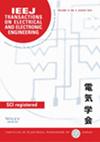求助PDF
{"title":"基于高压直流电中界面电荷累积的相对位置对地电位和电场的影响","authors":"Jun Zhang, Xiaobin Cao, Weidong Jin, Siyuan Zhang, Bide Zhang, Yu Zhang","doi":"10.1002/tee.24175","DOIUrl":null,"url":null,"abstract":"<p>With the development of high-voltage direct current (HVDC) engineering around the world, there has been increasing attention to the issue of selecting site for direct current (DC) grounding electrodes since the pollution coming from ground potential and electric field. As previous study result, the distance is closer to the grounding electrode, the influence is greater for ground potential and electric field, as well as vice versa. Through proposing the analysis approach of equivalent interfacial charge accumulating, the article goes beyond this previous general-conclusion and extracts the relative position conception from the mono-distance for further studying on weakening their impacts on the environment. In comparison with the previous results, the research finding shows that the movement of relative position is able to achieve the best distribution of ground potential or electric field corresponding to different soil-layered structure, furthermore, the specific mathematic formula about the best relative position has been derived by the accumulated charge model proposed. Finally, the results have been demonstrated by simulation calculation of the CDEGS software for a practical HVDC project in China, moreover, regarding soil resistivity variation related to the different seasons, the optimized relative position about 13 ~ 24 km has been adopted in the real HVDC grounding project as a suggested site. It reveals that the underlying relative position behind the mono-distance could be applied to selecting the site of grounding electrode as reference in the future. © 2024 Institute of Electrical Engineers of Japan and Wiley Periodicals LLC.</p>","PeriodicalId":13435,"journal":{"name":"IEEJ Transactions on Electrical and Electronic Engineering","volume":"20 1","pages":"29-40"},"PeriodicalIF":1.0000,"publicationDate":"2024-07-30","publicationTypes":"Journal Article","fieldsOfStudy":null,"isOpenAccess":false,"openAccessPdf":"","citationCount":"0","resultStr":"{\"title\":\"The Influence of Relative Position on Ground Potential and Electric Field Based on Interfacial Charge Accumulation in HVDC\",\"authors\":\"Jun Zhang, Xiaobin Cao, Weidong Jin, Siyuan Zhang, Bide Zhang, Yu Zhang\",\"doi\":\"10.1002/tee.24175\",\"DOIUrl\":null,\"url\":null,\"abstract\":\"<p>With the development of high-voltage direct current (HVDC) engineering around the world, there has been increasing attention to the issue of selecting site for direct current (DC) grounding electrodes since the pollution coming from ground potential and electric field. As previous study result, the distance is closer to the grounding electrode, the influence is greater for ground potential and electric field, as well as vice versa. Through proposing the analysis approach of equivalent interfacial charge accumulating, the article goes beyond this previous general-conclusion and extracts the relative position conception from the mono-distance for further studying on weakening their impacts on the environment. In comparison with the previous results, the research finding shows that the movement of relative position is able to achieve the best distribution of ground potential or electric field corresponding to different soil-layered structure, furthermore, the specific mathematic formula about the best relative position has been derived by the accumulated charge model proposed. Finally, the results have been demonstrated by simulation calculation of the CDEGS software for a practical HVDC project in China, moreover, regarding soil resistivity variation related to the different seasons, the optimized relative position about 13 ~ 24 km has been adopted in the real HVDC grounding project as a suggested site. It reveals that the underlying relative position behind the mono-distance could be applied to selecting the site of grounding electrode as reference in the future. © 2024 Institute of Electrical Engineers of Japan and Wiley Periodicals LLC.</p>\",\"PeriodicalId\":13435,\"journal\":{\"name\":\"IEEJ Transactions on Electrical and Electronic Engineering\",\"volume\":\"20 1\",\"pages\":\"29-40\"},\"PeriodicalIF\":1.0000,\"publicationDate\":\"2024-07-30\",\"publicationTypes\":\"Journal Article\",\"fieldsOfStudy\":null,\"isOpenAccess\":false,\"openAccessPdf\":\"\",\"citationCount\":\"0\",\"resultStr\":null,\"platform\":\"Semanticscholar\",\"paperid\":null,\"PeriodicalName\":\"IEEJ Transactions on Electrical and Electronic Engineering\",\"FirstCategoryId\":\"5\",\"ListUrlMain\":\"https://onlinelibrary.wiley.com/doi/10.1002/tee.24175\",\"RegionNum\":4,\"RegionCategory\":\"工程技术\",\"ArticlePicture\":[],\"TitleCN\":null,\"AbstractTextCN\":null,\"PMCID\":null,\"EPubDate\":\"\",\"PubModel\":\"\",\"JCR\":\"Q4\",\"JCRName\":\"ENGINEERING, ELECTRICAL & ELECTRONIC\",\"Score\":null,\"Total\":0}","platform":"Semanticscholar","paperid":null,"PeriodicalName":"IEEJ Transactions on Electrical and Electronic Engineering","FirstCategoryId":"5","ListUrlMain":"https://onlinelibrary.wiley.com/doi/10.1002/tee.24175","RegionNum":4,"RegionCategory":"工程技术","ArticlePicture":[],"TitleCN":null,"AbstractTextCN":null,"PMCID":null,"EPubDate":"","PubModel":"","JCR":"Q4","JCRName":"ENGINEERING, ELECTRICAL & ELECTRONIC","Score":null,"Total":0}
引用次数: 0
引用
批量引用

 求助内容:
求助内容: 应助结果提醒方式:
应助结果提醒方式:


